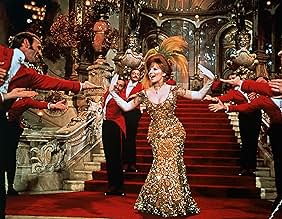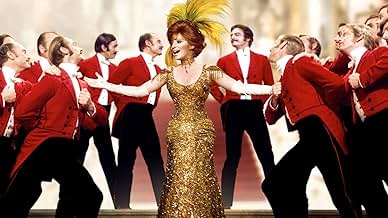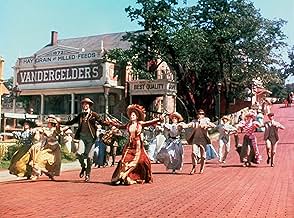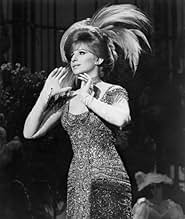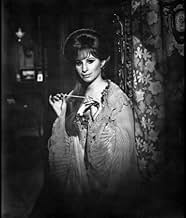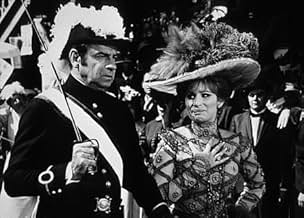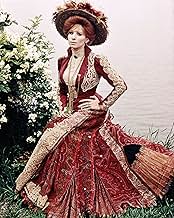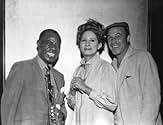Hello, Dolly!
- 1969
- Tous publics
- 2h 26min
La marieuse Dolly Levi se rend à Yonkers pour trouver un partenaire pour le millionnaire Horace Vandergelder, convaincre sa nièce, le fiancé de sa nièce et ses deux assistants de se rendre à... Tout lireLa marieuse Dolly Levi se rend à Yonkers pour trouver un partenaire pour le millionnaire Horace Vandergelder, convaincre sa nièce, le fiancé de sa nièce et ses deux assistants de se rendre à New York en cours de chemin.La marieuse Dolly Levi se rend à Yonkers pour trouver un partenaire pour le millionnaire Horace Vandergelder, convaincre sa nièce, le fiancé de sa nièce et ses deux assistants de se rendre à New York en cours de chemin.
- Réalisation
- Scénario
- Casting principal
- Récompensé par 3 Oscars
- 4 victoires et 13 nominations au total
- Laborer
- (non crédité)
- Paper Ricker
- (non crédité)
- …
- Townsperson
- (non crédité)
- Dancer
- (non crédité)
- …
Avis à la une
The Jerry Herman score is decidedly old-fashioned Broadway. Sondheim may be the greater composer but Herman gave us tunes we could hum and the production numbers here are terrific, in particular the title song which gives us Striesand, high-kicking waiters and Louis Armstrong. Purists will always prefer the Joseph Anthony version of Thornton Wilder's original play "The Matchmaker" but this is no disgrace, so put on your Sunday clothes and let's have a whale of a time.
"Hello, Dolly!" deserved the Oscars it won, such as musical direction, sound, and art direction-set design. About 15 years ago I stopped in the riverside village of Garrison, New York, to see where it was partially filmed. The real building that was adapted into Vandergelder's Hay & Feed was still there at the time, and "Vandergelder" was etched on the window pane from its use in the film. The bridge over the railway tracks is still there.
As much as I like the film as a whole, it does have some problems that could have been easily corrected. The early scene with Walter Matthau and Tommy Tune arguing over Ermengarde is overly dramatic and simply too theatrical. It might have been fine on Broadway, but the genre of cinema requires a bit of toning down. I blame this purely on Gene Kelly, the director, who should have known better. He is the one who is supposed to sense the pacing and delivery of lines. I get the impression he was trying to speed things up, knowing that there is a lot to fit into the picture. The screenplay was naturally required to closely follow the original material, but it could have been simplified a bit without sacrificing anything important. An example of this is the endless number of times that the audience is reminded that the main characters are going "to New York" by train. Once was enough.
Still, the music and choreography are superb, and carry the picture. Not everyone in it can sing as beautifully as Barbra Streisand, but it succeeds nonetheless. The number "Put On Your Sunday Clothes" is one of Hollywood's golden moments in terms of production quality. I have seen Carol Channing do the stage version and she was great, but I also feel that Barbra Streisand was perfectly adequate here. She can sing better than Ms. Channing and has real star quality.
If you visit the interesting Hudson River area of New York state, you will be warmly reminded of the scenic beauty in "Hello, Dolly!" Drop by the U.S. Military Academy at West Point to take the public tour and you will see the magnificent setting where the final wedding scene was done, minus the church of course.
Le saviez-vous
- AnecdotesAccording to Michael Crawford, he auditioned for Gene Kelly in his hotel room. Kelly asked him if he knew any tap steps, and tried to coach him on some on top of the coffee table. Crawford tried to imitate him, but was so nervous at the idea of dancing with the famous dancer and choreographer that he kept messing up. He was convinced he'd failed the audition, when Kelly told him "What we're looking for is an attractive idiot: My wife thinks you're attractive, and I think you're an idiot!", telling him he'd gotten the part.
- GaffesDuring opening credits, as Walter Matthau's name appears, a couple of wrecked modern automobiles (circa 1960s) can be seen dumped in foliage to right of railroad track.
- Citations
Dolly Levi: Money, pardon the expression, is like manure. It's not worth a thing unless it's spread around, encouraging young things to grow.
- Versions alternativesThere are two alternate takes during the number Before The Parade Passes By. They occur as Dolly Levi (played by Barbra Streisand) is running down the garden path to see the parade and is singing the line "Before the Parade Passes by".In the 35mm prints which were sent to movie theaters after the roadshow engagements, Dolly almost loses her hat while running. This was used for the home video version. The 70mm prints have a different take, in which Dolly did not have any hat problems. This was used for the DVD version.
- ConnexionsEdited into American Masters: Gene Kelly: Anatomy of a Dancer (2002)
- Bandes originalesJust Leave Everything To Me
(1964) (uncredited)
Written by Jerry Herman
Performed by Barbra Streisand and Chorus
Meilleurs choix
- How long is Hello, Dolly!?Alimenté par Alexa
Détails
- Date de sortie
- Pays d’origine
- Langue
- Aussi connu sous le nom de
- ¡Hello Dolly!
- Lieux de tournage
- Sociétés de production
- Voir plus de crédits d'entreprise sur IMDbPro
Box-office
- Budget
- 25 000 000 $US (estimé)
- Montant brut aux États-Unis et au Canada
- 400 881 $US
- Week-end de sortie aux États-Unis et au Canada
- 221 204 $US
- 11 août 2019
- Montant brut mondial
- 403 127 $US
- Durée
- 2h 26min(146 min)
- Couleur


